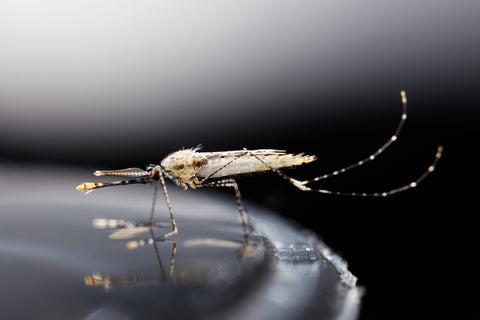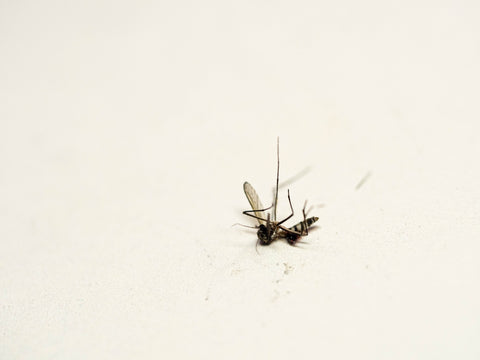Your efforts to control mosquitoes start at home. What does that mean?
The odds are high that when you see one mosquito, there’s usually a whole lot more of them hiding away or gestating in their larvae stages, ready to start attacking you.
And if you saw the mosquito inside your house then beware – there’s a chance that a female mosquito has managed to lay her eggs somewhere in the property. If you’re not careful, you could end up with a swarm of the little biters that will have you on the phone to a pest control professional because you’re scared of the effects the mosquitoes could have on your health.
That means you need to know what sorts of places these irritating bugs like to use as their breeding grounds. After all, getting rid of those breeding areas means no more eggs, resulting in fewer mosquitoes infesting your property.

Place 1 – Standing Water in Your Garden
While your garden isn’t technically inside your house, it’s connected to it and can offer a veritable labyrinth of places for mosquitoes to lay eggs. Any source of standing water is a danger – ponds and puddles, in particular. Both can be humid and stagnant, offering the perfect breeding ground.
Of course, you can’t go around draining every puddle you find. Plus, you likely have your pond because you’re keeping fish, so sacrificing them to keep mosquitoes away isn’t an option. But there are a few things you can do to minimize the potential of those sources of standing water becoming a mosquito’s breeding ground.
For ponds, consider adding netting above the water. It won’t deter the mosquitoes entirely, but it serves as a barrier that could keep a few out. Puddles are trickier to confront. Some recommend using dishes of alcohol as the odor apparently repels mosquitoes. Sticking with that same line of thought, Tougher Than Tom’s all-natural Mosquito TNT combines sugar, yeast, and water to create an attractant for mosquitoes. When combined with the ingredients inside, the solution in these pots becomes toxic to the bugs, causing them to die before they ever have a chance to lay eggs outside.

Place 2 – The Humble Houseplant
In addition to standing water, mosquitoes love dark, humid places that provide plenty of cover and moisture.
That makes some houseplants a threat.
Specifically, any plants that you need to keep out of direct sunlight, such as rabbit foot ferns and prayer plants, can attract mosquitoes once they’re watered. Slow water absorption rates or overwatering creates the standing bodies of moisture discussed earlier – ideal for female mosquitoes seeking out breeding grounds.
Refreshing the water in your houseplants helps with this issue. Lack of stagnation means mosquitoes are less attracted to any standing water in the pots. You could also consider using chemical insecticides on the plants, though this is a far less attractive form of protection for any homeowner who has pets or small children wandering around.

Place 3 – Air Conditioning Units
Sticking with the water theme, your air conditioning could offer the perfect place for mosquitoes to breed. That may seem like a strange idea at first. After all, air conditioners tend to absorb moisture, turning the warm air containing it cold using special compressor units that should make them the last place mosquitoes want to inhabit.
The problem is twofold.
First, the moisture pulled out of the air has to go somewhere. In most air conditioning units, that “somewhere” is a drain pan – a viable source of standing water if you fail to clean it out properly. Second, a lack of maintenance could lead to your air conditioner leaking, especially in any ducts used to pump air throughout your home. The constant dripping of improperly maintained pipework could create pools of water where you can’t see them. Given that mosquitoes can squeeze through gaps as small as 9mm (about 0.35 inches), they have a good chance of finding those hidden pools to use them for breeding before you even know they’re there.
Thankfully, the solutions to both problems are simple – regular maintenance. Empty your drain pan every week and keep your pipework in good repair.
Place 4 – Garages and Sheds
Even if you manage to successfully keep mosquitoes out of your home, the adjoining buildings can offer breeding grounds, too. Both garages and sheds are danger zones – both are dark and, in the case of sheds, can often become humid during summer months.
If you’re able to keep these areas perfectly dry, you have little to worry about. But given that isn’t always a possibility (condensation can wreak havoc, after all), a solid solution is to install a screen. Multiple, in fact, on all of the windows and doors leading into these buildings.
It’s not a perfect solution – remember that mosquitoes can squeeze through 0.35-inch gaps – but combining screens with regular sweeps of the garage and shed to clear away standing water means they’re less likely to become breeding areas.

Place 5 – Bird Baths
Bird baths are odd in that they can act as both mosquito attractants and mosquito repellants.
On the repellant side, the baths can draw in species of birds that enjoy snacking on the nasty little bugs. If you have hummingbirds, house wrens, yellow warblers, purple martins, or downy woodpeckers in your area, you have birds that will eat any mosquitoes they find.
Thus, having a bird bath is a great idea.
But what if you don’t have those mosquito-guzzling bird species? In that case, a bird bath can become a breeding ground if you’re not careful. Leaving the water in the bath to stand for a day or two could lead to it becoming stagnant – perfect for roaming female mosquitoes looking for places to lay their eggs.
Thankfully, the solution to this problem is as simple as refreshing the water in the bird bath every day or two. By avoiding stagnation, you also avoid creating breeding areas for mosquitoes.

Place 6 – Guttering
Every home has gutters. They’re a requirement for funneling rainwater away from the property and into a draining system. But that mention of rainwater should get your Spidey senses tingling – rainwater is stagnant and if it collects in your gutters you have a breeding ground waiting to happen.
Interestingly, the water threat doesn’t come from the guttering itself. Rainwater tends to be able to seep through blockages eventually, so you’ll rarely find standing water inside the gutters. But what could happen is that blockages lead to water building up and spilling over, potentially into your garden or even a basement, creating pools that draw in mosquitoes.
So, clear your gutters. Try to do it twice per year (more if you live in an area with a lot of tree cover) so water can flow without obstructions.
Place 7 – The Bathroom
With all of this talk of water, it’s probably a surprise that it’s taken so long to get to bathrooms as potential breeding grounds. But they can be if you allow your hygiene practices to slip or if your bathroom isn’t properly ventilated.
Start with your toilet.
Repeated flushing should be enough to ensure that toilet water is never standing for long enough for it to become a problem. But consider using toilet cleaners regularly to keep the water as fresh as can be. And, as women will tell you, closing the toilet lid is always a good idea.
From there, move on to repair work – any leaking faucet or pipe can be a water source that’s ideal for female mosquitoes. Finally, it’s not recommended to use indoor insecticide or spray inside the bathroom. You don’t want the chemicals from either coming into contact with your skin when you’re washing yourself.

Place 8 – Pet Bowls
The standing water theme continues with your pets’ drinking bowls. Little Fido needs water daily, but you’ll often find that your pets don’t drink every drop you put into their bowls.
Resist the temptation to leave the water from one day in the bowl for the next.
Not only will your pet be less likely to drink water that’s been standing for a while, but you also run the risk of creating standing water for mosquito breeding. That’s especially the case if you keep a water bowl outside in the shade during summer – dark and humid is perfect for a mosquito that’s ready to lay a clutch of eggs.
Then there’s the health issue – mosquitoes can spread heartworm to dogs. Contrary to popular belief, heartworms aren’t formed from ingesting mosquito larvae. Instead, the worm larvae are transmitted to dogs through mosquito bites. So, by leaving water to stagnate in bowls, you’re potentially creating more mosquitoes, leading to a higher chance of your dog getting bitten.
Keep Water at Bay
The biggest takeaway here is that standing water is a danger to any homeowner who wants to keep their property free of mosquitoes. By simply clearing up water, you present fewer places for mosquitos to breed and reduce your risk of an infestation.
Beyond that, there are some more active steps you can take to attack mosquitoes in the home if you’re already dealing with an infestation. A fogger, which pumps a combination of water and insecticide into the air, works well as a temporary fix, assuming you keep away from the area where the fogger is operating. But eliminating sources of standing water, combined with using sprays and LED lamps, such as those offered by Tougher Than Tom, is far more effective in the long term and doesn’t require the use of nasty chemicals.


